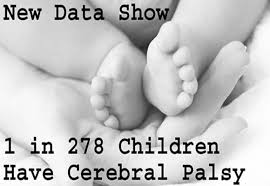Cerebral palsy is one of the most common congenital (existing before
birth or at birth) disorders of childhood. About 500,000 children and
adults of all ages in the United States have the condition.
The three types of CP are:

Signs and Symtoms
Signs and symptoms can vary greatly. Movement and coordination problems associated with cerebral palsy may include:
Other neurological problems
Brain abnormalities associated with cerebral palsy also may
contribute to other neurological problems. People with cerebral palsy
may also have:
Cerebral palsy is caused by an abnormality or disruption in brain
development, usually before a child is born. In many cases, the exact
trigger of this abnormality isn't known. Factors that may lead to
problems with brain development include:
Cerebral palsy Support and Intervention
click the links below to read more about cerebral palsy
- spastic cerebral palsy — causes stiffness and movement difficulties
- athetoid cerebral palsy — leads to involuntary and uncontrolled movements
- ataxic cerebral palsy — causes a disturbed sense of balance and depth perception
Signs and Symtoms
Signs and symptoms can vary greatly. Movement and coordination problems associated with cerebral palsy may include:
- Variations in muscle tone, such as being either too stiff or too floppy
- Stiff muscles and exaggerated reflexes (spasticity)
- Stiff muscles with normal reflexes (rigidity)
- Lack of muscle coordination (ataxia)
- Tremors or involuntary movements
- Slow, writhing movements (athetosis)
- Delays in reaching motor skills milestones, such as pushing up on arms, sitting up alone or crawling
- Favoring one side of the body, such as reaching with only one hand or dragging a leg while crawling
- Difficulty walking, such as walking on toes, a crouched gait, a scissors-like gait with knees crossing or a wide gait
- Excessive drooling or problems with swallowing
- Difficulty with sucking or eating
- Delays in speech development or difficulty speaking
- Difficulty with precise motions, such as picking up a crayon or spoon
Other neurological problems
Brain abnormalities associated with cerebral palsy also may
contribute to other neurological problems. People with cerebral palsy
may also have:- Difficulty with vision and hearing
- Intellectual disabilities
- Seizures
- Abnormal touch or pain perceptions
- Oral diseases
- Mental health (psychiatric) conditions
- Urinary incontinence
- Random mutations in genes that control brain development.
- Maternal infections that affect the developing fetus.
- Fetal stroke, a disruption of blood supply to the developing brain.
- Lack of oxygen to the brain (asphyxia) related to difficult labor or delivery. This is rarely acause.
- Infant infections
- Traumatic head injury
-
Maternal health
Certain infections or health problems during pregnancy can significantly in
- German measles (rubella).
- Chickenpox (varicella).
- Cytomegalovirus.
- Toxoplasmosis.
- Syphilis.
- Exposure to toxins.
Infant illness
Illnesses in a newborn baby that can greatly increase the risk of cerebral palsy include:
- Bacterial meningitis.
- Viral encephalitis.
- Severe or untreated jaundice.
Other factors of pregnancy and birth
Other factors of pregnancy or birth that are associated with an increased risk of cerebral palsy include:- Premature birth.
- Low birth weight.
- Breech births.
- t
Cerebral palsy Support and Intervention
click the links below to read more about cerebral palsy
And if you are here in Lagos and need any information about Cerebral Palsy
contact
Source : Mayo Clinic
No comments:
Post a Comment